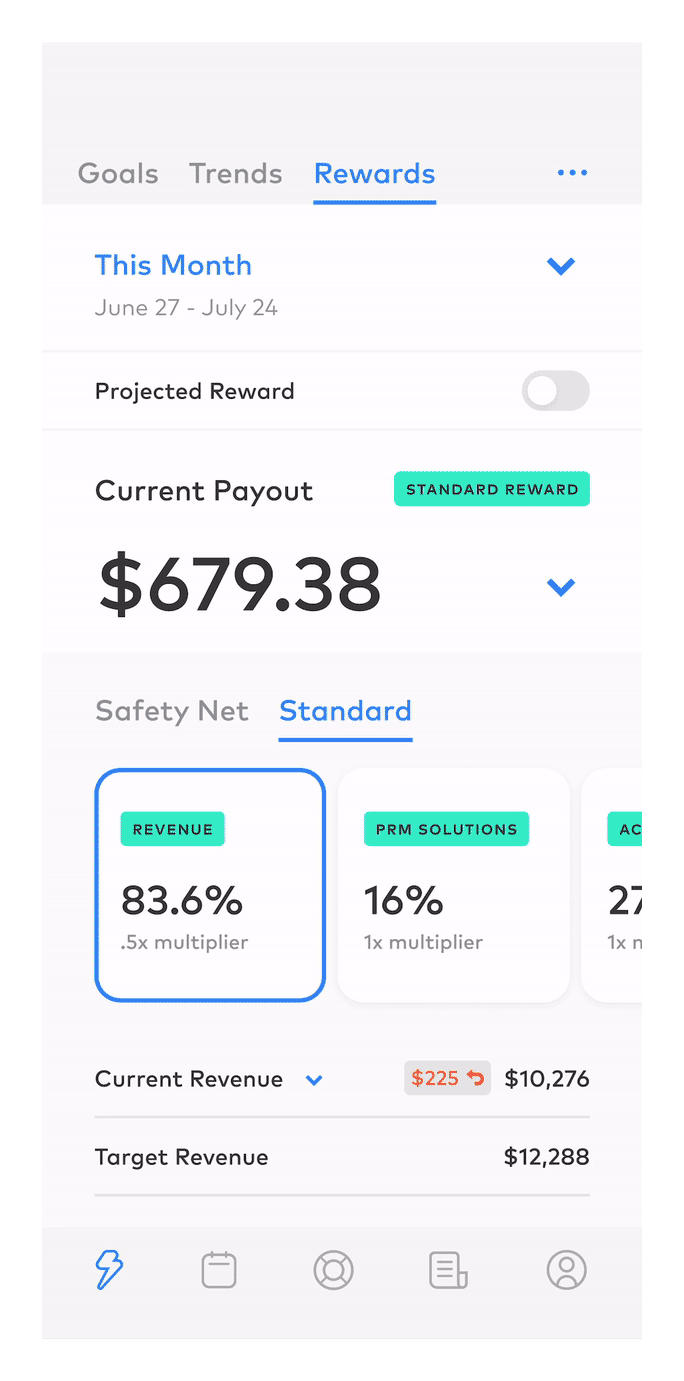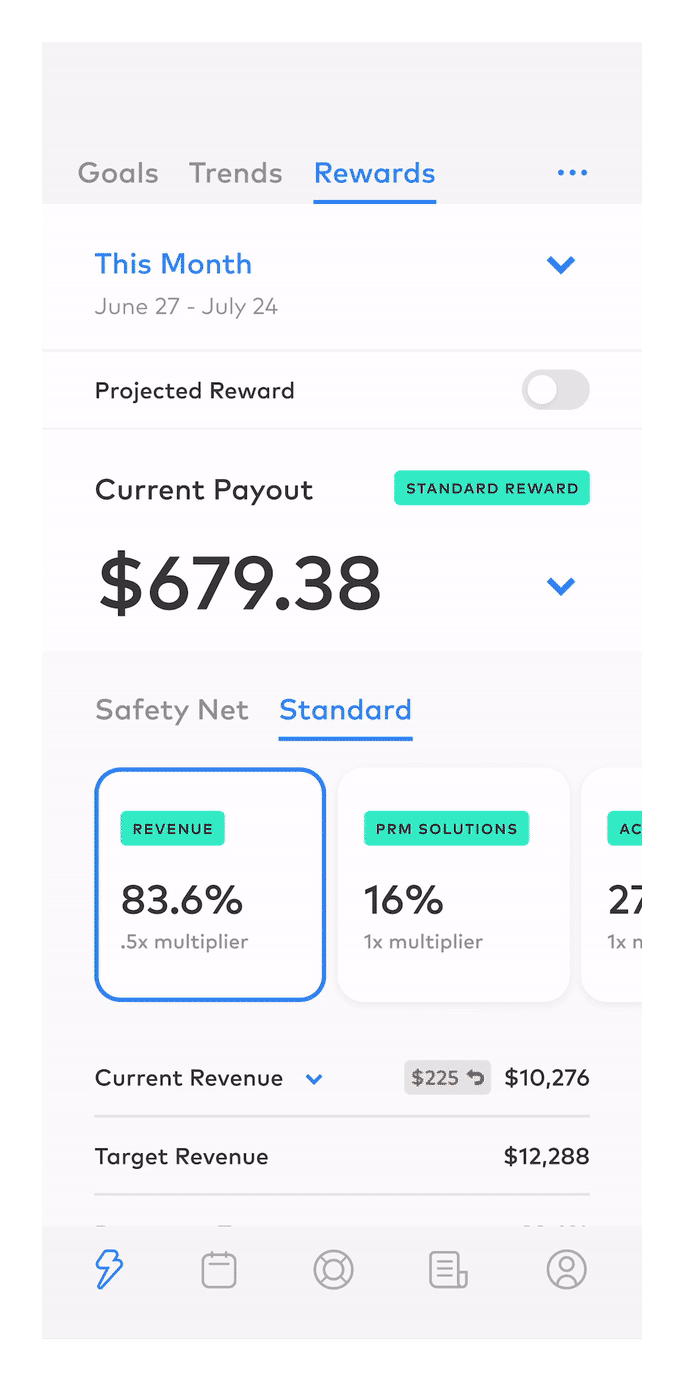Designing a Rewards Program that cuts through complexity
By breaking down complex calculations and representing them in compelling ways, we were able to motivate Experts to incrementally improve their performance.
Transformed dense calculations into a presentation layer that Experts could easily understand
Introduced concepts around projections and daily goals that were integral in the success of the program
Presented design and got buy in from business stakeholdersContext
Over time, the role of an Expert changed from solely focused on delivering an experience to primarily a sales position. This inevitable shift was necessary to counter our rising operating costs, and it meant that Experts would sell solutions to customers and generate incremental revenue in each visit. This was a big change for Experts and required a new approach to how we recognized and rewarded them.
The Mechanics
Our rewards program blended a variety of business metrics in a balanced way. In order for an Expert to achieve, and hopefully excel in, their rewards, they would need to meet revenue and solution targets, along with a high NPS based on customer feedback. The program also included a safety net to help ramp new Experts who weren’t yet proficient in positioning solutions.
For the program to reward Experts in a way that was commensurate with their performance, while also ensuring the reward pay outs didn’t impact our operating costs, a complex model was developed.
Each business metric included a set of multiplier tiers, so as an Expert moved up in their performance, their percent payout would increase in a scaled way. I’ve outlined the calculations below that formed the basis of the program.
The calculations that created the foundation for Expert Rewards. I needed to represent them in a way that Experts could easily understand.Once the model was defined, I needed to come up with a design that broke down the math into something understandable to Experts. Our stakeholders told us that the inputs would change in future months as they continued to refine the program, so the design had to be able to swap in and out inputs when they changed.
How can we create a design that flexes to support different inputs in the future?
Rich Tabs and Expandable Components
To break down the calculations, I organized the content into a clear hierarchy. Rich tabs showed Experts where they stood on each metric at a glance. By selecting a tab, Experts would see secondary information to understand how we calculated their current multiplier.
When an Expert wanted to understand a part of their reward more fully, in-line expandable components helped Experts break down how each input was derived.
Organizing the program with rich tabs and expandable components gave us a flexible system for future changes. When a metric was added or replaced, or when the calculation of an input changed, the design allowed us to localize the change and make line item updates, instead of needing a larger, structural redesign.
Design as a Motivator
Designing the program in an understandable way was important, but I wanted to ensure the way Experts were interacting with their rewards was also motivating to them.
We realized the program’s construct introduced a big gap in an Experts understanding of their month-end pay out. Since their reward was based on their monthly performance, which was accrued, Experts wouldn’t be able to accurately predict their pay out until the month ended.
How can we let an Expert know on day one if they are tracking towards their performance goals?
To make sure an Expert’s view of the program was as valuable on day one as it was at the end of the month, I introduced Projected Rewards. Using an Experts average daily revenue, projected number of shifts in the month, and their historical performance, an Expert could get a pretty accurate prediction of their end-of-month pay out. This was a big motivator and drove a lot of engagement throughout the month.
Showing Incremental Improvement
At an aggregate, Projected Rewards was a great way for Experts to understand how their performance early in the month was impacting their pay out at the end, but to truly motivate Experts, we needed to break down their performance more. We needed a way to show how each customer visit had an impact.
How can we show Experts that each customer visit has an affect on their performance, and as a result, their reward pay out?
To accomplish this, we added daily goals. These daily goals laddered up to their monthly performance, by breaking down their monthly revenue target over each shift.
Experts would track their performance each day, and could see how one shift’s performance would ripple out to impact their monthly goal. This helped to move performance away from a larger aggregate to something they felt in control of and able to impact with each visit.
The daily revenue chart helped to take an aggregate monthly view of their performance and break it down into daily goals.Outcomes
Measuring success was difficult with frequent changes to the program. Metrics and qualifiers would update monthly because our business stakeholders were trying to find a solution that was motivating Experts, and also ensured the payouts we gave them didn’t negate increased revenue from the program.
While the revenue increase was modest, we did see promising behavioral changes attributed to Rewards. We wanted Experts to convert deliveries to experience visits, because it provided us opportunity for incremental revenue. Incremental revenue meant a higher Reward pay out, so incentives were aligned. We also saw a drop in chargebacks based on how they were reflected in the program. If a customer ended a service or subscription up to 30 days after the sale, it would be deducted from the Expert’s total revenue amount in the program. This ensured Experts weren’t pushing services a customer didn’t want, as any chargebacks would negatively impact an Expert’s Reward pay out.
Outcomes over 6 months






